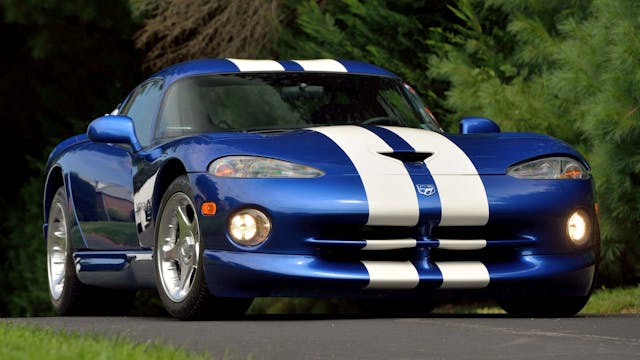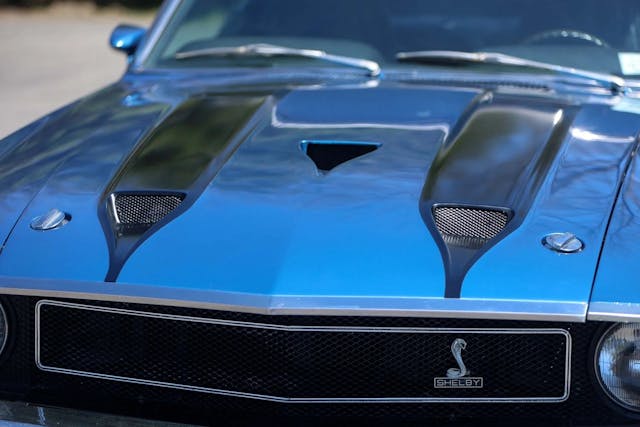Media | Articles
The 10 coolest cars with NACA ducts
At the beginning of World War I, just 11 years after the Wright brothers’ first flight, the United States was lagging behind Europe in aviation technology. In an effort to catch up, Congress formed the National Advisory Committee for Aeronautics (NACA) on March 3, 1915. The organization, which would become the National Aeronautics and Space Administration (NASA) in 1958, reported directly to the president and began to develop wind tunnels to study streamlining and aerodynamics. The research rapidly increased the range and speed of American aircraft.
In the 1930s and 1940s NACA developed an airfoil design for wings and propellers that can be found on many important WWII aircraft including the P-51 Mustang. NACA contributed greatly to the first supersonic flight in 1947, achieved by Chuck Yeager at the stick of the X-1 experimental airplane, and thereafter turned its attention to missile technology and manned space flight.
Many of the organization’s aerodynamic achievements began to influence the design of automobiles, and the NACA ducts appeared on cars in the mid-1950s.
“In 1951 the original NACA report on it was declassified, and the design of the duct became public information, available for use by anyone,” wrote Motor Sport magazine in 2000. “Racing cars were an obvious application, but it wasn’t until 1956 and the emergence of Frank Costin’s redesigned Vanwall that someone had the nous to exploit it.”
That same year, small recessed scoops also appeared on the quarter panels of Ford’s Continental Mark II. They’re not exactly NACA ducts, but they’re close.
Marketplace
Buy and sell classics with confidence
Developed in the agency’s wind tunnels, the low-drag air inlet submerged into the bodywork with curved sides and a blunt, squared-off end is still commonly found on race cars and high-performance production cars today. The NACA duct has become an iconic statement of speed.
Presented in chronological order, here are our picks for the 10 coolest high-performance street cars with NACA ducts.
1969–70 Ford Mustang Shelby GT350/GT500

Carroll Shelby didn’t have much to do with the Shelby Mustang by 1969; however, the car’s distinctive fiberglass hood with three NACA ducts assures both the GT350 and the GT500’s places on this list. The center scoop feeds the carburetor, while the two on the sides help draw hot air out of the engine compartment. The hot air then exits through two open vents closer to the cowl.
The hood design remained the same over the two model years, though the 1970 cars were actually leftover 1969 models and received black hood stripes for visual distinction.
1973 Pontiac GTO

This is the only muscle car from General Motors ever to wear NACA ducts. Two appeared in the center of its hood—and they were fakes. They did not feed the carburetor as originally intended but were instead blocked off by the factory. Allegedly, Pontiac did offer the rest of the prototyped induction system through dealers and about 10 cars with functional scoops were built. One is said to exist today.
Regardless, the muscle-car craze was quickly winding down by 1973, and the redesigned Pontiac GTO went over with a thud. The body style lasted just one year and Pontiac only sold just 4806, making it the worst-selling GTO of all time.
1974–90 Lamborghini Countach

Officially, we haven’t taken any measurements, but the award for the largest NACA ducts has to go to the Lamborghini Countach, which first appeared at the 1971 Geneva Auto Show and reached production three years later.
The mid-engine supercar features a single and sizable NACA duct on each side, beginning on each door and covering most of the quarter panels, feeding its massive radiators to keep its big V-12 engine cool. Production lasted until 1990 with nearly 2000 produced. Its successors, the Diablo, the Murciélago, and the Aventador, which just finished an 11-year production run, do not feature NACA ducts.
1980–86 Renault R5 Turbo

A homologation special for Group 4 rally competition, this little Renault is basically a Le Car with radically flared hips, rear-wheel drive, and a 158-hp, turbocharged 1.4-liter four-cylinder engine mounted in place of its back seat. About 5000 were built over six years. Two iterations, the Turbo 1 and the Turbo 2, each have a single, small NACA duct atop the left rear quarter panel.
The R5 Turbo was styled by Marcello Gandini at Bertone, who designed the Countach and penned many other machines featuring NACA ducts, including the Alfa Romeo Montreal and the Lamborghini Espada.
1987–96 Ruf Yellowbird

In 1987, Road & Track declared the Ruf CTR the world’s fastest production street car. It received its nickname “Yellowbird” during testing that year when it achieved a terminal velocity of 211 mph and accelerated to 60 mph in 3.6 seconds. It was powered by a twin-turbo, 3.4-liter flat six said to make 463 hp. The car cost $223,000. According to Ruf, 29 examples were built and 20 to 30 more were created from customer 911s.
If you haven’t seen the footage of this car drifting the Nürburgring, check it out on YouTube immediately. Look for its two large NACA ducts, one atop each rear wheelwell flare.
1987 Callaway Corvette

For many Gen Xers, the first car they remember with NACA ducts is the 1987 twin-turbo Callaway Corvette. Three years before the DOHC ZR-1, the most powerful Corvette was created with option code RPO B2K. It sent your new Corvette to Callaway Engineering in Connecticut, where its 5.7-liter V-8 was pumped up from with a pair of turbochargers and intercoolers.
Even sweeter were the two NACA ducts Callaway carved into Corvette’s hood. Sadly, however, they would last only one year. According to Callaway, 445 Corvettes were ordered with the RPO B2K option over the four-year run, so only 123 coupes and 65 convertibles featured the NACA duct hood.
1987–92 Ferrari F40

This was the last Ferrari personally signed off by Enzo himself. Built to commemorate the company’s 40th birthday, the successor to the 288 GTO featured a mid-mounted, twin-turbo 2.9-liter V-8 and two small NACA ducts in its front decklid.
It was the quickest, fastest, most expensive, and most powerful Ferrari of all time, with over 470 hp and a body made of aluminum, carbon fiber, and Kevlar. To save weight, the interior was race-car-raw, without door handles, glovebox, carpet, or sound system. The F40 was a stark contrast to its rival at the time, the all-wheel-drive Porsche 959. Just 1311 F40s were built, with a top speed just shy of 200 mph.
1996–2002/2013–17 Dodge Viper

This one needs a little more explanation. The original Dodge Viper, which went on sale in 1992, did not have a NACA duct in its hood feeding fresh air to its V-10 engine. In 1996, however, Dodge gave the sports car a bit of a facelift and introduced a coupe version called the Viper GTS.
The GTS was the first Viper with the large NACA duct in its hood, but Viper roadsters remained scoopless. An all-new Viper coupe and convertible arrived in 2003. Although a scoop remained in the hood of each style, it was not a NACA duct. This arrangement remained the lay of Viper land through 2010. The model left us for a little while, finally returning for a brief four years in 2013 as a coupe only … happily, with an aerodynamic NACA duct.
2008–15 Mitsubishi Evo X

This is the only four-door sedan on this list—the 10th and final generation of the Mitsubishi Evolution, a turbocharged and all-wheel-drive rally car inspired by the rival of the Subaru WRX STI. Known for its flared flanks and oversized rear spoiler, the last of the Evos also wore a single NACA duct in its hood. Although it wasn’t functional on the street-going model, the duct was put into use on Evos in rally competition. These cars were powered by a turbocharged, 16-valve 2.0-liter four-cylinder that made 291 hp and 303, in the Final Edition.
2009–2020 Nissan GT-R

NACA ducts did not appear on the R32, R33, or R34 versions of Nissan’s Skyline GT-R. However, they’ve been an important part of the aerodynamics and performance of the R35 GT-R, which was launched in 2009 and remains in production 14 years later. There have always been two on the supercar’s hood, and on 2019’s 600 hp GT-R NISMO, they were incorporated into the composite structure of the panel. They’ve never directed air into its boosted 3.8-liter V-6; instead, they duct cool outside air onto the engine’s twin turbochargers for cooling.
***
Check out the Hagerty Media homepage so you don’t miss a single story, or better yet, bookmark it. To get our best stories delivered right to your inbox, subscribe to our newsletters.






I just had a look at my 2013 Jaguar XKR-S convertible in the garage, Lots of nose action, does it qualify?
I will be more than happy to sell it to anyone, 30K miles, triple black for 60k USD.
Bob Walker 250 208 9890 Brentwood Bay BC Canada
Nope. Not NACA.
Agreed. A true NACA duct has a specific mathematically derived curvature to each of the side walls and a distinct, crisp 90-degree angle at the top edges. The design principle was that the side wall curvatures actually INCREASED the airspeed at the intake, and the sharp angle where the duct was cut into the main surface created a vortex effect, the airflow spilling into the intake along each side like 2 tornados laid sideways.
a couple of these were kind of pushing the limit as to a real NACA Duct.
1970 Challenger had a pair of functional hood scopes on the 340 equipped cars.
Agreed – moore than pushing the limit, just plain not NACA ducts.
C6 Z06? Also 1985 Iroc camaro?
What about 1971-1973 Mustang? Ours has 2 NACA ducts for Ram Air induction.
Because they are not NACA ducts. NACA ducts by design are flat and not raised above the surface. The Mustang intakes are raised above the surface.
If we go by that definition, then the 69-70 Shelby is also raised above the surface. The R5 also appears raised above the surface.
Because they are not real NACA ducts and that era of mustangs were bloated, ugly caricatures of themselves.
Matter of taste I’d guess, being from that era, I remember that 71-73 Mustang hood being about as “badass” as any from the Muscle Car era.
Jealous?
Ah common, the ’83-’87 Lotus Esprit Turbo has be on this list
How about the Lotus Elite?
Yes, Frank Costin added them to the hood of racing Elites.
How do you leave off the 71-73 mustang?
they left off the Mustang because they can’t see past chev.
Because they are not NACA ducts. NACA ducts by design are flat and not raised above the surface. The Mustang intakes are raised above the surface.
I’m with Trent on this, the Mach 1 hood for those years has to be the coolest. Whether they functioned or not or whether they were recessed, or not. Add the factory pop-up hood locks, there ya go.
I don’t disagree that the Mach-1 hood cool but the article is about cars with NACA ducts and the Mach-1 hood ducts, while cool, aren’t NACA.
Where are the GT-Porsches?
What about the Alfa Romeo Montreal?
Yes! And what about the Lamborghini Espada? Another early one!
Yes- one of the more beautiful uses of the NACA duct. Though it is not functional.
Didn’t the 88 or so T-bird turbo coupe have one?
Yes they did. Good call!
Sure did, maybe not a pure NACA duct design but close, and they were functional! Providing air to the intercooler.
Yes, both the 87 and 88 T-Bird turbo Coup had 2 NACA ducts on the hood. They provided cooling air to the air-to-air inter cooler mounted next to the 2.3 liter 4 cylinder turbocharged engine. The manual transmission equipped Turbo coupe’s ran 15psi boost pressures so they needed all the inter cooling they could get.
Alfa Montreal for sure. It doesn’t work but it is one of the defining features of the car.
90’s BMW 850i Alpina also came with one in the center of the hood for upper intake cooling, I believe.
And Lotus continues to uses NACA ducts, out of sight, in the undertrays of the Elise, Exige, Evora and Emira for engine bay cooling.
I can confirm this, my Esprit has two obvious NACA ducts in the sills and my Evora has them in the aluminum tray under the engine
Almost correct on the Viper. 1998-2002 RT/10 (Roadster) also have the NACA Duct. Same hood as the GTS.
James-
Thank you for the response
NACA ducts actually appeared on the R34 GT-R from the 2001 model, the V-Spec II and V-Spec II Nür
The ducts should be functional in order to be included on the list. Some excellent suggestions have been offered to replace the Pontiac.
One could argue that non of these hood scoops, fake or open, are actually “functional” are speeds short of the aircraft they were originally designed for.
Some small planes can become airborne at around sixty-five mph, many jets in the 150-160 mph range. If the car has an opening, air can enter and exit. If the duct feature exist for purely aesthetic purposes, it should not be on the list, even if it looks cool.
E85/6 Z4M’s have NACA ducts under the car, directing air towards the massive finned aluminum differential cover. Behind that cover is a diffuser to pull the air through. Quite a nice piece of engineering.